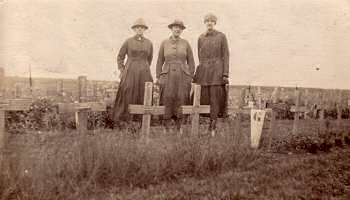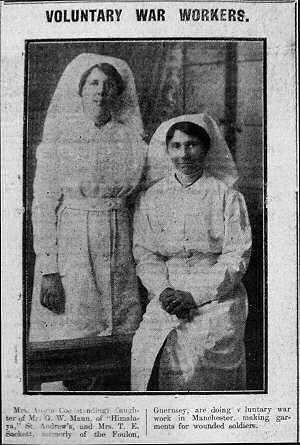|
The Davis booklet also notes that women had "even
invaded the offices of lawyers and the sacred precincts
of our Banks". Girls had become business canvassers
and insurance agents, and lady reporters on newspapers
were said to have become an institution. It goes on to
state that "Out of doors we have become accustomed
to see girls performing the duties of tram drivers and
conductors, chauffeurs, and in at least one instance the
driver of a 'chair'".
The Post Office also employed girls as messengers delivering
telegrams. 'The Guernsey Weekly Press' of 17th January
1917 contains a picture of the first two "conductorettes"
- Miss Agnes Sebire of Lancresse and Miss Dylis Richards
of Pike's Corner. By June 18th of the same year, Miss
Sebire had been promoted to tram driver, and was said
to drive "with conspicuous ability".
In the same month, lady bell ringers at the Vale Church
rang 15 changes on the six bells.
Many Guernsey women went to England and Europe to work
in areas that supported the war effort, such as making
munitions, sewing uniforms and nursing or helping the
wounded in other ways.
|
|
|
Davis notes that one Guernsey woman, Miss de Putron,
was an administrator of the WAACs, while another was engaged
in teaching Braille at St Dunstan's Hospital for Blinded
Soldiers.
'The Guernsey Weekly Press' carried articles throughout
1917 featuring women who had left the island for similar
purposes. Nurse Galliott of Carmel, St Martin's went to
Salonika with the Queen Alexandra's Imperial Military
Nursing Service, after serving for a year in a large military
hospital in England. Nurse Duquemin, daughter of the States
Engineer, spent Christmas 1917 serving at a military hospital
in Cheshire.
Mrs T.E. Sackett of the Foulon, St Peter Port and Mrs
Austin Coe, daughter of Mr Mann of St Andrew's went to
do voluntary work in Manchester making garments for wounded
soldiers.

Miss Ada Le Poidevin (right) of Nocq Road,
St Sampson's went to Salisbury Plain then to France
with the Salvation Army with the BEF.
|
|

Mrs Austin Coe and Mrs T E Sacket, both from Guernsey,
working in Marchester garment making for wounded soldiers
|